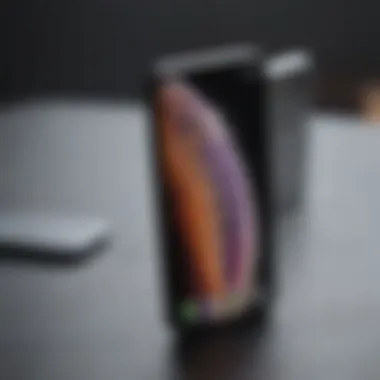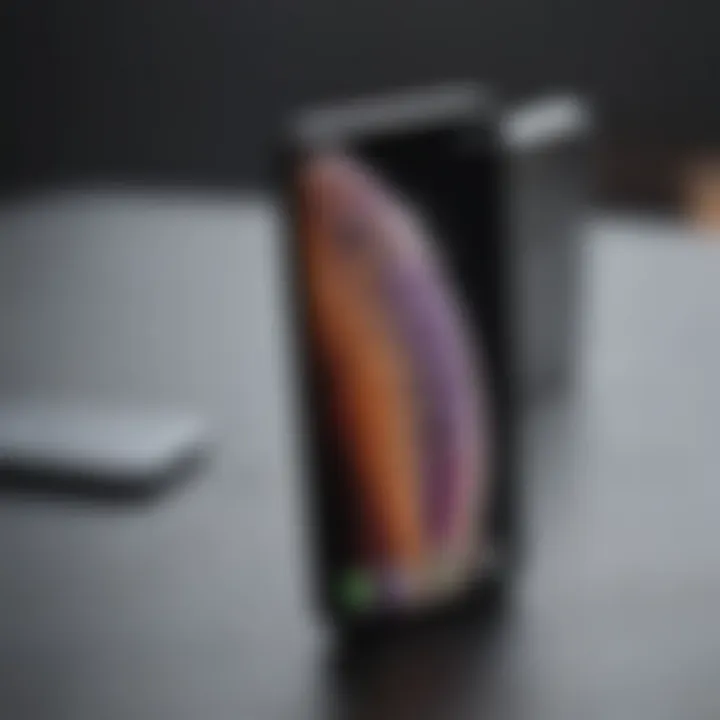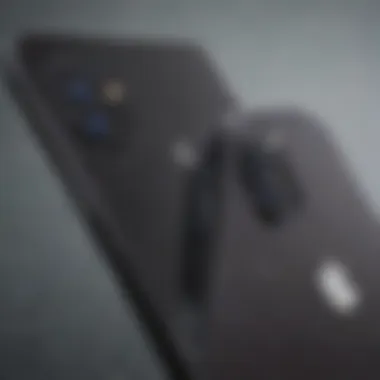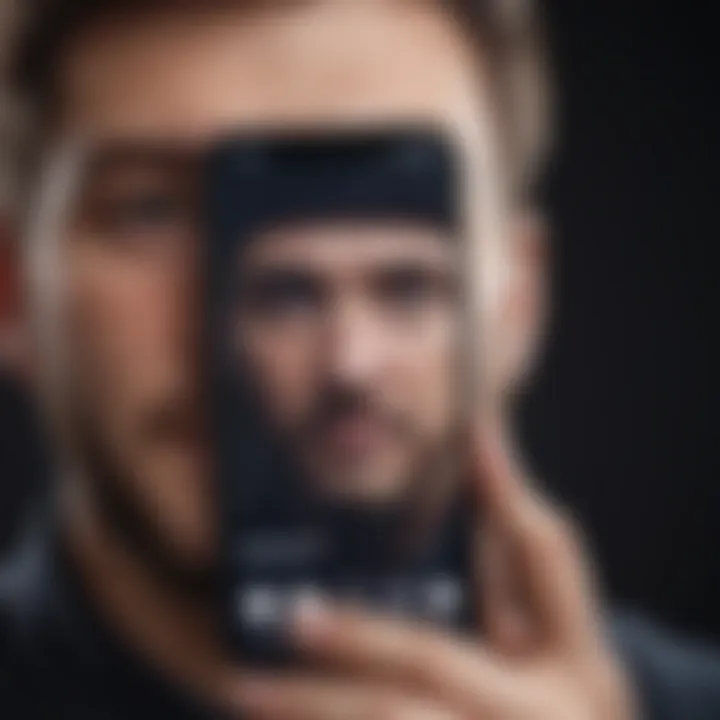The Evolution of the iPhone Notch: Design and Impact


Intro
In tech circles, the introduction of the iPhone notch sparked considerable debate. Some hailed it as a breakthrough in design, while others viewed it as a necessary evil for maintaining sleek aesthetics. This seemingly small cut-out has not only defined the look of the iPhone but has also influenced smartphone design at large. This article will dive into the deep waters of how the notch has evolved, its significance for both users and manufacturers, and what it could mean for the future of mobile devices.
The notch made its debut with the iPhone X in 2017, representing a shift in how smartphones could utilize screen real estate. Beyond just appearing trendy, the notch encapsulates several underlying technological advancements. It brought forth innovations in facial recognition, improved audio technology, and a host of new challenges for developers and designers alike. Thus, it is essential to examine not just the visual aspect of the notch, but also how it transformed interactions between users and their devices.
This exploration will be structured around various facets: the product itself, user experience, the relationship with earlier models, and potential future developments. Through a comprehensive analysis, we hope to elucidate how this feature has managed to enlive the mobile technology landscape and what it implies for usability and design moving forward.
As we peel back the layers of this design element, we will see that the notch is more than just a cut-out; it's a reflection of ongoing technological evolution and consumer preferences.
Preamble to the iPhone Notch
The introduction of the iPhone notch marked a pivotal shift in smartphoe design. It not only changed the aesthetics of mobile devices but also redefined user interaction. The notch, as a visual element, was not simply about housing the front-facing camera and sensors, it became a symbol of innovation. Understanding its origin and evolution helps us to grasp its significant influences on current and future designs.
Design is more than just aesthetics; it encompasses usability. The iPhone notch is a perfect example of balancing both. By adapting to the notch, developers and designers were compelled to rethink user interfaces, creating apps that work harmoniously with this new structure. This discussion bridges together both technical and experiential perspectives, making the notch an indispensable aspect of modern smartphone architecture. Without a clear understanding of the notch, we risk overlooking key changes in user behavior and industry standards.
Historical Context of Smartphone Design
Before diving into the specifics of the notch, it’s essential to understand the timeline of smartphone developments. Early designs, such as the original iPhone released in 2007, featured a physical home button and thicker bezels. As consumer preferences evolved, manufacturers began to explore full-screen designs.
Around the time of the introduction of the iPhone X in 2017, many smartphones were competing for a minimalist aesthetic. Brands like Samsung and LG explored edge-to-edge screens, but Apple's shift to the notch brought about a radical departure from the flat conventions.
The context here speaks volumes. With the rise of competition in the smartphone market, brands were pushed to innovate not just in hardware but also in design.
Tim Cook's Vision and Strategic Decisions
Tim Cook's leadership has been characterized by a meticulous focus on user experience and brand longevity. His strategic decision to embrace the notch was both a bold and calculated risk. Under his direction, Apple aimed for a more immersive experience, prioritizing screen real estate.
In a world where innovation is expected at lightning speed, Cook ensured that the iPhone remained at the forefront. The introduction of the notch was emblematic of Apple's strategy—blending form and function. Many naysayers initially criticized the notch, but Cook consistently emphasized the importance of technological progression over immediate aesthetics.
By focusing on the functionality offered by Face ID and other technologies nestled within the notch, Tim Cook not only revamped how consumers engaged with their devices but also set the stage for future innovations in the smartphone industry.
The Birth of the Notch Concept
The introduction of the notch in smartphone design marked a pivotal moment in the trajectory of mobile devices, especially for Apple with the launch of the iPhone X. This design choice was not just a stylistic whim but rather a blend of aesthetic and functional considerations that reflected a broader evolution in smartphone technology.
Foreword of the iPhone
In 2017, Apple rolled out the iPhone X, a device that steered away from its predecessors and set a new standard in the mobile market. The iPhone X came with an edge-to-edge display, but this revolutionary design required a unique compromise: the notch. Nestled at the top of the screen, it houses crucial components like the front camera, ambient light sensor, and the innovative Face ID technology.
The significance of this notch was multifaceted. Not only did it provide an avenue for advanced facial recognition without sacrificing screen real estate, but it also represented a clean break from the traditional design norms embraced by earlier models. Instead of buttons and bezels, the phone offered a sleek, uninterrupted view, inviting users into an immersive experience that underscored the device's advanced features.
Technical Innovations Behind the Notch
The iPhone X's notch was not just a matter of rearranging the components; it heralded a wave of technical advancements that profoundly influenced future designs. Two key elements stand out: Face ID technology and the miniaturization of components.
Face Technology
Face ID technology was the hallmark of the iPhone X, marking a significant leap from fingerprint sensors. This system used sophisticated infrared sensors and a dot projector to create a detailed 3D map of the user's face. The key characteristic of Face ID is its ability to securely unlock the device by recognizing the user, even in varying light conditions.
What sets Face ID apart as a beneficial choice is its perceived efficiency and security over traditional methods. Statistics suggest that it is less likely to be fooled than its fingerprint counterpart, making it a popular choice among consumers. However, reliance on facial recognition does spark discussions about privacy, as it requires extensive biometric data. This aforementioned tension highlights a fragile balance between convenience and security in modern technology.
Miniaturization of Components


Another driving force behind the notch was the miniaturization of components. As manufacturers aimed to fit more technology into smaller spaces, Apple tackled this through precise engineering and innovative design. Notably, the miniaturization process allowed critical elements like the front camera and sensors to fit neatly within the notch itself, thus freeing up more screen space for the user interface.
The distinct advantage of this miniaturization is clear: it enables a sleek, full display while maintaining the essential functionalities that users expect from a smartphone. Yet, the downside is that such compact arrangements can lead to challenges in heat management and the risk of component fragility.
In summary, the birth of the notch concept with the iPhone X was a calculated decision reflecting the intersection of aesthetics, technology, and user demand. As we continue to explore the implications of this design element, it becomes clear that Apple's path may set trends for the entire tech industry moving forward.
Design Implications of the Notch
The introduction of the notch on the iPhone not only marked a significant shift in visual aesthetics but also brought about numerous implications for user interface design. As designers and developers grappled with the new challenges that the notch presented, it became clear that this feature was not just a means to house sophisticated technology but also a statement about the direction of mobile device design. The iPhone notch set a precedent for how screen real estate could be maximized while cleverly integrating essential functionality.
A Shift in Visual Aesthetics
The iPhone notch signified a departure from traditional smartphone design by introducing a new visual element into the display layout. Before the notch, smartphone screens adhered to more conventional designs with bezels around their edges. The shift to a notch created a more immersive viewing experience by allowing screens to extend closer to the device's edges. This stylistic choice gave rise to a sleeker, more modern look, setting it apart from its predecessors.
However, this new design did not come without its critics. Some users viewed the notch as an unnecessary interruption in an otherwise seamless screen, a blemish on an otherwise flawless device. Nonetheless, many recognized its allure; it symbolized innovation and paved the way for a brave new world in smartphone aesthetics.
User Interface Adaptations
Status Bar Adjustments
One of the most immediate effects of the iPhone notch was the need for considerable adjustments to the status bar. The notch creates a unique footprint at the top of the display where notifications and other vital icons must be placed. This requirement transforms how developers design applications. The key characteristic is that the status bar now operates within the framework of the notch, meaning that designers must be cognizant of the space around it, ensuring critical information is easily visible without interfering with the notch itself.
This adaptation has its benefits. For one, users have a clearer view of their notifications, while the space surrounding the notch allows for additional icons without cluttering the main screen. That being said, there are disadvantages; some app layouts may need to be tweaked to fit within this new constraint, which can complicate design processes.
App Design Challenges
Another critical consideration arising from the notch is how applications are designed and laid out. Developers now face a unique challenge: ensuring that app interfaces do not sever aesthetically, falling victim to the notch's encroaching space on the user's visual experience.
One of the most significant challenges here is finding a balance between content display and the notch's presence. This characteristic requires developers to rethink how they present their content. For instance, some may choose to implement margins or adopt specific color schemes that blend well with the background of the notch, thus transforming it from a perceived flaw into a design opportunity.
While designing around the notch can push creative boundaries, some developers find it disconcerting. Many agree that it requires a steep learning curve to adapt existing designs or anticipate how new apps will fit within this unusual format. Nevertheless, rising to these challenges contributes to a more refined end product, often resulting in innovative user experiences that ultimately benefit users.
"The notch, while controversial, has undeniably defined a new frontier in smartphone design, reshaping our expectations of screens and usability."
Consumer Reception and Critique
Understanding consumer reception and critique is pivotal when discussing the iPhone notch. It goes beyond mere aesthetics—this section illuminates how users responded to this design element, which in turn shaped further innovations and adjustments in iPhone models. Notably, the public's acceptance or backlash influences future design decisions across the smartphone industry.
Initial User Reactions
When the iPhone X hit the market with its distinct notch, the initial reactions were a mixed bag. Some users admired the sleek, modern look that deviated from traditional designs while others were less impressed, expressing frustration over the interruption of the screen. Comments flooded social media, with enthusiasts lauding it as a "bold step" in smartphone design, while skeptics coined phrases like "the awkward guppy" to describe the notch’s appearance. This duality in reaction proves essential—the first impression carries weight, setting the tone for later discussions.
Many early adopters began sharing their experiences in reviews and forums, making it clear that the functionality offered by the notch might soften visual qualms. For some, the Face ID technology that the notch housed became a persuasive element. A sentiment often echoed was that form aligns with function, as users recognized the security and convenience this feature provided.
Long-Term Feedback and Adaptations
User Surveys
User surveys surfaced as a central method for evaluating the ongoing sentiments about the notch over time. These surveys, often carried out post-launch, gathered both quantitative and qualitative data. The key characteristic of this approach lies in its ability not just to gauge initial feelings, but to capture shifts in public perception. It was fascinating to see how early skepticism often transformed into acceptance or even appreciation as updates rolled out. Respondents frequently indicated that once they got accustomed to the notch, it began to feel like an integral part of their user experience.
The main advantage of user surveys is their accessibility; they are a popular choice for tech companies to collect direct feedback quickly. Surveys reflect a broad range of opinions and provide a clear picture of acceptance levels, matching users’ emotional reactions with their day-to-day use of the device. However, there’s a caveat: surveys typically represent a segment of users, often skewed towards vocal critics or ardent fans. This can limit broader conclusions about the average consumer experience.
Community Forums


Community forums represent another vital resource for understanding how the iPhone notch has been received. Platforms like Reddit have hosted in-depth discussions where users exchange ideas about the notch and all related topics. This organic interaction really amplifies the collective voice of the user community.
The unique feature of community forums lies in their real-time dialogue. Conversations evolve, reflecting changes in sentiment as software updates and new hardware iterations emerge. Such forums are particularly beneficial because they allow for direct engagement with both positive and negative feedback. Users appreciate a sense of community, offering support and sharing tricks to get the most out of their devices despite initial design grievances.
On the downside, community discussions can sometimes spiral into echo chambers, amplifying discontent or misconceptions. A few users might dominate conversations, overshadowing more balanced perspectives. Still, the vibrant exchange of opinions in these forums illustrates an active engagement that serves as crucial feedback for designers and engineers alike.
"I didn’t love the notch at first, but I have to admit, it feels less bothersome now. It’s just part of the phone."
In sum, the exploration of initial reactions and long-term feedback contributes immeasurably to our understanding of the iPhone notch. It underscores the balance being struck between design innovation and user comfort, shaping how we move forward in both user experience and technological advancements.
Comparative Design Trends in the Industry
The smartphone industry is always on the cutting edge, forever striving to outdo itself with each new release. The incorporation of the iPhone notch marks a notable shift in design philosophy within this fast-evolving landscape. This section sheds light on the influence of the notch compared to other emerging design trends, such as punch-hole displays and edge-to-edge innovations. Understanding these trends is key to grasping the broader narrative of mobile technology and user experience.
Notch vs. Punch-Hole Displays
When comparing the iPhone notch to punch-hole displays, we see a significant divergence in aesthetic and functional philosophies. Each design offers a solution to the challenge of incorporating front-facing cameras and sensors.
The iPhone notch first debuted with the iPhone X, providing a symmetrical design that housed essential technology for Face ID. This design choice was not merely for looks; it represented a bold stance in prioritizing advanced technology while making it a part of the phone's visual identity. On the flip side, punch-hole displays, prevalent in many Android devices, feature a small circular cut-out in the screen itself. This allows for a more uninterrupted display, moving a step closer to the full-screen experience many users crave.
Evolution of Smartphone Displays
Full-Screen Vision
Full-screen vision is the holy grail for smartphone designers and users alike. The goal here is simplicity and immersion. With brands racing to create devices that utilize every inch of the screen, full-screen vision has become a compelling choice.
The unique feature of this approach is that it minimizes any distractions on the screen itself. Users can engage with content without the typical frills of design clutter. However, as sleek as it might be, achieving full-screen vision brings its own hurdles, particularly in housing essential components like cameras and sensors. This is where the iPhone notch first took center stage, offering an innovative compromise.
Edge-to-Edge Innovations
Edge-to-edge innovations represent another leap forward, pushing the envelope for display technology. This design seamlessly blends the screen into the body of the phone. It doesn't just look appealing but also enhances usability, allowing for more content to be displayed at once.
The critical characteristic of this type is the maximization of display real estate. Users appreciate how it accommodates immersive gaming and cinematic experiences. However, like full-screen vision, this approach faces the challenge of accommodating technology — specifically cameras and ear pieces. Edge-to-edge designs often necessitate creative workarounds, such as under-display cameras, but these solutions can still be in their infancy.
"As screens grow larger and bezels disappear, the challenge lies in creating devices that are both aesthetically pleasing and technologically sound."
Future of the Notch
As we look ahead to the future of the iPhone notch, it becomes pivotal to understand how this design element might evolve and influence next-generation devices. The voice of the consumer and the pulse of technology trends will play significant roles in shaping its trajectory. The industry's continuous push towards seamless designs that prioritize user experience will definitely catch everyone's attention.
Predictions for Upcoming iPhone Models
Anticipating the designs of future iPhone models brings excitement. Many experts agree that the next iterations of the iPhone may very well either minimize or completely eliminate the notch. A lot of folks believe that Apple is mulling over various options to streamline their designs. For instance, it’s rumored that future models might incorporate a smaller, less obtrusive notch or possibly go notch-less altogether.
Another prediction involves advancements in camera technology to enable even thinner bezels, creating that coveted full-screen experience without the notch ruining the visual. Users could be looking at iPhones with display mechanisms that either hide the front-facing camera or move it under the display entirely.
Potential Design Alternatives
Considering the potential evolution of the iPhone notch, we can unpack two significant alternatives that are being discussed in various tech circles.
Under-Display Technology
Under-display technology focuses on placing essential camera and sensor functionalities beneath the screen itself. This presents a fascinating opportunity to provide a complete full-screen experience. One key feature of this technology is that it allows for a seamless view—there’s nothing obstructing the display.


The advantages of incorporating under-display technology in future iPhones are numerous. First, it enhances visual aesthetics significantly, offering an uninterrupted view that appeals to many users. Second, it could contribute to increasing screen size without expanding the device footprint, which is a much-desired characteristic in the current market.
However, there are challenges associated with this technology. The quality of photos taken with hidden cameras may not match those from traditional placements, potentially hampering user experience. Hence, finding a balance between aesthetics and functionality will be crucial.
Full-Screen Sensors
Full-screen sensors aim to embed the various sensors required for functions like Face ID directly into the display itself. This characteristic allows for functionality without visible disruptions.
A key advantage of full-screen sensors is their ability to streamline the design significantly. Users enjoy a cleaner look while still benefiting from cutting-edge technology. This kind of setup also leads to improved durability, as fewer exposed components may result in devices that are less prone to damage.
Still, the perfecting of this technology remains a work in progress, and ensuring accuracy and reliability in sensor performance is crucial for user confidence, especially concerning security features like Face ID.
"Future smartphone designs will either validate or rethink the concepts we currently accept. As we move forward, understanding user preferences will be as crucial as the technology itself."
Cultural Impact of the Notch
The iPhone notch is more than just a hardware feature; it's a cultural icon in the realm of technology. Its introduction marked a pivotal moment in smartphone design, tapping into broader societal themes around minimalism, functionality, and the user experience. Understanding its cultural impact is essential to grasping how it reshaped not only Apple’s product line but also industry standards and consumer expectations.
Influence on Tech Culture
The notch, introduced with the iPhone X, became synonymous with a particular vision of technology that resonates deeply with users. It added a new dimension to the tech narrative—one that prioritizes sleek design without sacrificing essential functions. This design choice sparked lively discussions among tech enthusiasts, professional designers, and average users alike.
Many admirers argue that the notch has become a symbol of innovation. It represented Apple's willingness to push boundaries and challenge norms. By integrating Face ID technology and eliminating the physical home button, Apple set off a trend of slim bezels, driving competitors to adopt similar designs.
On forums like Reddit, users often debate the merit and functionality of the notch. Such discussions illustrate how integral the notch has become in conversations about smartphone design. It has led to an evolution in how people view their devices. Instead of merely tools for communication, they have transformed into fashion statements and reflections of personal identity.
For instance, many users began customizing phone cases and wallpapers to showcase or complement the notch, thereby embedding it deeper into everyday culture. This interplay between utility and aesthetics reflects an important cultural shift where technology is not just used but also showcased.
The Notch as a Design Statement
The iPhone notch stands as a bold design statement that embodies complexity within simplicity. In an age where smartphone designs were trending towards more uniform, uninspired aesthetics, Apple introduced the notch as a means of differentiation. The simple act of including a notch—rather than hiding essential components—was, in itself, a declaration of values prioritized by the brand: innovation, honesty in design, and a seamless user experience.
This philosophy has sparked conversations across design communities and consumer markets alike.
- Minimalism and Functionality: The notch exemplifies how design can serve dual purposes. It not only houses essential technology (like the front camera and sensors) but does so in a way that's visually interesting.
- Industry Influence: Following Apple's lead, other brands such as Google and OnePlus began to adopt their own variations of the notch, demonstrating its widespread acceptance as a stylistic choice.
- Consumer Interpretation: Beyond just a visual element, users have made the notch a canvas for creativity. Various apps and wallpapers have been designed specially to complement or play off the notch, creating a subculture around it.
The iPhone notch signals a shift in tech culture; it's no longer merely about usage but about representation and identity in an increasingly digital world.
As we look forward, it’s clear that the iPhone notch has transcended its original function, becoming a semantic marker in technology and design. Its cultural impacts ripple through user behaviors, industry standards, and broader societal conversations, making it a pivotal point in the history of smartphone evolution.
Finale
The critical examination of the iPhone notch throughout this article has shed light on its multifaceted significance in the realm of smartphone design. It's not merely a design choice; it's a reflection of technological progress and user interaction. Slicing through the mundane chatter, the notch symbolizes Apple's commitment to merging form with function, pushing the boundaries of aesthetic appeal and practical usability.
Summarizing the Notch's Impact
The iPhone notch’s impact extends far beyond its initial reception. While some users initially critiqued its daring design, over time it evolved into a familiar sight on devices, establishing a standard in mobile technology. The following points encapsulate its significance:
- Pioneering New Formats: Apple’s risk in implementing the notch galvanized competitors to explore their own unique designs, fostering a wave of innovation.
- Usability vs. Aesthetics: The delicate balance between screen real estate and functionality emerged, forcing designers to reconsider how they present information neatly on the display.
- Cultural Symbol: The notch began as a point of contention but transformed into a distinct marker of identity for Apple, setting a trend other brands attempted to emulate.
"The notch wasn’t just a cut-out, it was an invitation to rethink the smartphone layout and how we interact with our devices."
Looking Forward
As we peer into the horizon of smartphone technology, the future of the notch remains speculative yet tantalizing. Several possibilities loom ahead:
- Alternative Design Innovations: Companies may pivot towards under-display components, progressively diminishing or entirely removing the need for the notch system.
- Evolving User Expectations: As mobile devices become more integral to daily life, user preferences will likely dictate design shifts towards more immersive, unobtrusive experiences.
- Technological Advancements: With rapid advancements in camera technology and display interface, we can anticipate a reinvention of how features like Face ID can be seamlessly integrated without physical cutouts.
In summation, the evolution of the notch is not just a nostalgic nod to past designs but a crucial stepping stone towards whatever comes next in mobile technology. Understanding its implications helps us appreciate the trajectory of innovation and adapt to forthcoming changes in a landscape that is always evolving.



